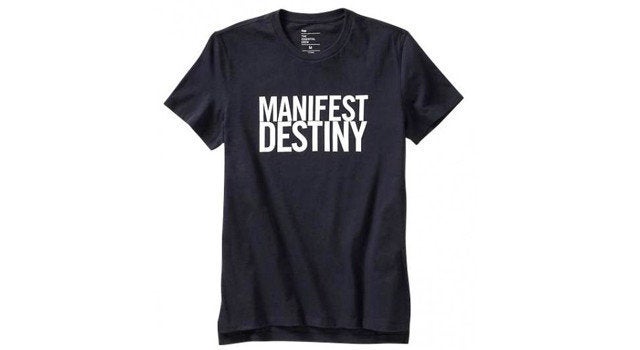
A T-shirt is just a T-shirt, right? What about a T-shirt that invokes the bloody policy of discrimination and oppression of your community? That's the issue surrounding Gap and a shirt that said "Manifest Destiny" across the front. For American Indians like me, the shirt is particularly offensive, calling to mind a brutal history against Native people since Columbus arrived to North America but especially since the founding of the United States. The issue stung more because Gap was my first employer.
Here's what happened. About a month ago, a black and white T-shirt with the words "Manifest Destiny" went on sale at Gap stores. The uproar was almost immediate across social media. A Change.org petition was created that got a lot of attention. The story went viral, especially across Native communities. Meanwhile, the shirt's designer, Mark McNairy, doubled down on the T-shirt, tweeting: "MANIFEST DESTINY. SURVIVAL OF THE FITTEST." (He later deleted the tweet and apologized.) Gap has since removed the shirt from its shelves, issuing a statement of apology that read in part: "Based on customer feedback, we will no longer offer the T-shirt in our stores or online."
So what is Manifest Destiny and why does it offend so many people to see these words on a T-shirt? Manifest Destiny is the imperialistic 19th century view that America was destined to expand across the North American continent -- no matter who or what was already there. It is estimated that thousands of Indian tribes were displaced or wiped out -- and that between 30 and 60 million buffalo were reduced to just thousands in the decades after European explorer first arrived to North America. Manifest Destiny literally rid the land of buffalo, our sustainable life force. The Lakota, my people, relied on this sacred animal to meet their basic needs for food, shelter, clothing and ceremony. The buffalo sustained American Indian people for thousands of years, but beginning in the early 19th century, the buffalo began disappearing in staggering numbers.
Here on my home reservation of Pine Ridge, in South Dakota, the 1890 Massacre at Wounded Knee was a direct result of "Manifest Destiny." So when I see this T-shirt with "Manifest Destiny," literally in black and white, it triggers something in me deeply. Manifest Destiny has impacted generations of Native people -- and still to affects us to this day. Today the Pine Ridge Indian reservation, an area roughly the size of Connecticut, has the lowest per capita income in the entire country -- and many Indian reservations are suffering in a similar way.
So Gap removed the shirt from its shelves and apologized. The story is over, right? I think it's just beginning. This is an opportunity to have a real dialogue about this subject. As we have all seen in the past year, many designers and corporations have continued to make cultural offensive decisions like this T-shirt.
This is not the first time a clothing company has released culturally offensive material. Earlier this year, Nike released the Black and Tan shoe, the name referring to a British paramilitary unit known for brutal tactics against Irish citizens and revolutionaries in the 1920s.
These corporations should realize that there are Native people still here, like me and my friends and family, who uphold our culture, and our history and our own identity. And we are not for sale! We are not Halloween costumes! Because of people parodying our culture by wearing headdresses and war paint, it has become normalized and acceptable.
The employees and management I know at Gap have always supported me and my culture. But a half-hearted apology by both Gap and the designer is not enough. This should be a real wake up call to all designers and corporations: do your research. You could hire Native artists. You could hire Native people to give your campaigns and products authenticity and historical perspective. You could learn your history -- it's the history of all of us as a country. You could use this as an opportunity to make real sustainable change and a positive impact.
This is what my family, community and I are all about. We have a deep investment in making sustainable economic change through self-reliance, entrepreneurship, nutrition -- including the returning of the buffalo to our land. Let's use this controversy about a T-shirt to talk about more than clothing -- let's talk about who we're selling to and why.
Kimberly Tilsen-Brave Heart, a member of the Oglala Lakota Sioux Tribe, is an entrepreneur (Painted Skye Consulting). Her family has built a successful food company, Tanka Bar, based on healthy living, sustainability and the return of the buffalo. Tilsen-Brave Heart does regular training around self-empowerment, cultural diversity and sensitivity, customer service and professionalism to Native communities throughout the country. See her website and like it on Facebook.